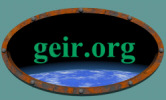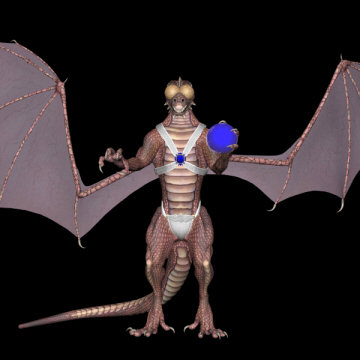
 |
|||||||
|
|
|
|
|
|
|
Dragons |
 |
|||
Homeworld: |
Draco, Sector +09,-01,-01 | |||
Ecology: |
Nitrogen-Oxygen-Water (H:F:1:7) | |||
Biology: |
DNA I | |||
Languages: |
Dragon Speech, Federation A | |||
Human Contact: |
4063CE (hostile encounter in 3547CE) | |||
FTL Status: |
Earlier civilization: 143,054BC, Current civilization: 3205CE | |||
Current Status: |
Independent unified state until 4837CE, Competing Dragon states from 4837CE | |||
Environment |
Ideal |
Tolerance |
||
Atmosphere: |
.32B O2 | .19-.40B O2; CO2 < .01B | ||
Temperature: |
292K | 270-300K | ||
Gravity: |
0.71G | .05-1.05G | ||
Other: |
Humidity 20% | Humidity 05-80% | ||
The Dragons are an aggressive winged race occupying thousands of systems to the spinward of Human Space. The Dragons rose to interstellar civilization over a hundred thousand years ago, only to fall victim to the Hitzarchi Plague and the instability of their own sun. After the final nova of their sun in 4837CE, the Dragons became and remained a warring, fragmented race.
Dragons look like their namesakes in Human folklore. An adult Dragon stands about two meters tall, but normally weighs less than 60 kilograms. Dragons have two four-clawed arms and two four-clawed feet, a set of bat-like wings spanning 4-5 meters and a superficially reptilian brown or reddish scaled head and body balanced by a long tail. With two large multifaceted eyes and a muzzle complete with two nostrils and a razor-tooth mouth, a Dragon lives up to its name. Capable of spitting a flammable phosphoric organic compound up to fifteen meters, they further perpetuate the stereotype and give credence to theories that ancient Dragon explorers reached Terra in the distant past. Dragons wear little clothing or adornment, as most encumbrances interfere with their soaring ability. Older Dragon adults often grow a tuft of hair-like cilia on their foreheads, a sign of status.
Dragons are sequential hermaphrodites, passing thorough male and female stages numerous times during their adult life. They evolved from soaring carnivores nesting in the high mesas and peaks of their mountainous homeworld. Draco (F'trk'ktash in Federation C transliteration) orbited a late main sequence F1V star with high metallicity. It was a small dense planet ripe in heavy metals and radioactives. Draco combined low surface gravity (.71g) and a dense (1.7 bar) atmosphere, allowing Dragons to fly and soar considerable distances over its arid, volcanic landscape. Early Dragon nests consisted of twenty to thirty related individuals, including young who, after hatching from crystalline eggs, reached adulthood in twenty standard years. Dragons require a diet rich in phosphorus and heavy metal supplements (including lead and arsenic) in order to maintain their long-term health. Dragon language consists of harsh near-ultrasonic squeals and barks that no Human can master. Inter-species communication occurs though translation machines.
Modern Dragon society is martial, hierarchical and regimented, with individuals and their nestmates competing for power through normally ritualized protocols that are occasionally bypassed by violence and assassination. A nest is led by its elders, usually three or four senior members who retain sole breeding rights. A group of up to a dozen nests combines to from a clan, and a few dozen clans form a Pride. One nest is dominant within a clan and one clan is dominant within a Pride, though these dominances may fluctuate suddenly and violently. Above the Pride level, the Dragons organize a Council of Prides, with one Pride dominant. These Prides-based societies often take the name of a dominant Pride and may constitute the entire Dragon population (often less than one hundred thousand individuals) on frontier worlds. Large councils of dominant Prides form a Nation, ruling a higher population world or a few systems. Nations remain the largest communities of Dragons in the Chaotic Era, but few persist for more than a few centuries or span more than a dozen systems.
Dragons are naturally long-lived, with a life span of 300-400 years, but a life expectancy of less than half that range. Dragon life extension efforts have not held a high priority, and have effectively double their life spans, but have had little effect on their often violence-plagued life expectancies.
The Dragons are currently experiencing their second period of interstellar civilization. Dragons first developed a technological culture over 150,000 years ago, probably in response to climatic conditions driven by their increasingly erratic home star. Written records of this earlier civilization still exist, some of these only recently recovered from failed colonies. Dragons developed macrojump drive while still politically fragmented and their early expansion was marred by wars and rivalries. In 142,830BC, the Dragons determined that their sun had less than a few tens of thousands of years left in its main sequence lifespan, and the competing governments combined forces to begin a monumental engineering effort aimed at extending their sun's lifespan by "stirring" the sun's core with electromagnetic currents. While this project continued, Dragon explorers set out across the Orion Arm, looking for potential colony sites and other races that might help them survive. Eventually, they founded over two hundred colonies and contacted several races, including the Dantum. Unfortunately, the Dragons also located the homeworld of the Hitzarchi and brought back the quantum nanomechanical plague. The Hitzarchi Plague destroyed Dragon civilization and led to the catastrophic failure of the stellar engineering effort, causing sub-nova flares that killed most of Draco's population, but which ironically extended the sun's main sequence existence by another hundred thousand years.
In the ensuing dark age, the Dragons fell back to a pre-industrial culture. Eventually, all but two old nearby Dragon colonies perished, though some worlds persisted for tens of thousands of years before succumbing to genetic or resource exhaustion. The colony world of Tiamat (a Human name for the world T'rfaztir) recovered to atomic technology by 900CE and began signaling Draco via radio waves across a gulf of forty light years. After five hundred years without a response, the now mid fusion era Tiamat Council of Prides launched a sub-light expedition that reached the Dragon homeworld in 1896CE and discovered a severely balkanized early industrial culture. Radioing back to Tiamat, the expedition began the slow process of uplifting the Dragons of Draco while they waited centuries for two additional generation ships to arrive. By 3000CE Draco and Tiamat had formed a late fusion era sub-light culture and had begun work to rebuild the solar engineering program. In 3205CE Draconian researchers rediscovered macrojump drive, and within a decade, they had discovered the only remaining Dragon colony, the iron age culture on Smaug (Tschartzu), fifty-five light years from Draco.
The Dragons began a slow expansion, resettling dozens of worlds and advancing in macrojump technology until they developed their unique Type III engine design in 3509CE. In 3547CE, Human and Dragon fleets briefly met in a skirmish between exploratory forces, but true contact did not occur until 4063CE, when Dragon scouts reached the Imperial frontier. After a century and a half of peaceful coexistence which advanced the Dragons to Imperial Worm/Stasis technology, the Dragons discovered the Cygnian Humans on their Trailing frontier, and assuming an attempt by Humans to encircle them, launched surprise attacks on the Empire of Humanity. The Dragon War lasted from 4210-4216CE and ended after the Imperial Navy deployed Hellkings against the Dragon colony of Vrshada. Dragon-Imperial relations remained cool but peaceful during the remainder of the Imperial era, though disputes between Dragons and Khruzi eventually lead to a rift and break-off of contact between the two species. The Dragon Sphere, governed by a Supreme Council on Draco, retained control of external relations, and refused to allow Imperial contact with the Cygnian Humans, with whom the Dragons continued to have hostile relations.
The Mech Plague crossed into Dragon Space before 4760CE but had less immediate effect on the Dragons than other races. By tradition, the Dragons had maintained a number of their Type III macrojump vessels and their society relied less heavily on quantum technology. Aided with a low population density of self-sufficient Prides, these factors allowed the Dragons to redevelop a late macrojump culture within a few decades of the Plague's introduction. Starting in 4775CE military vessels of the Dragon Sphere crossed into former Imperial Space, officially to "keep the peace and restore civilization" but effectively to conquer Human worlds. Despite sporadic resistance and a coordinated defense by the Mendam Codominium, the Dragon Sphere absorbed over six hundred formerly Imperial worlds, nearly all Human, by 4837CE. They enslaved the Human populations, exterminated the Khruzis and set about "Draconizing" the worlds, adding trace elements, including phosphates and sulfates to the atmospheres of conquered planets.
In 4837CE, whether from a Plague-induced failure or some other error, the stellar engineering system around Draco's sun suffered a catastrophic malfunction, causing the sun to nova and annihilating all life on Draco. This catastrophe shattered the unity of the Dragon Sphere, and led to the balkanization of the two thousand Dragon worlds and their conquered systems. In the ensuing millennia, the Dragon race has remained fragmented, comprising mostly system-wide Prides or Nations with a few states of up to a dozen systems occasionally emerging only to fall into civil war. The Dragons maintain control over more than six hundred formerly Imperial worlds, in a slave-based society of Humans ruled by Dragon overlords. The Mendam Codominium continues to provide a bulkward against Dragon expansion and raiding, half fought thirteen recognized Dragon Frontier Wars between 5039 and 6352CE. Additional conflicts between Mendam-derived Defenders and assorted client states have slowly eroded the Dragon occupation, freeing just twenty worlds, but preventing further expansion.
The Dragon leader Djufszh'tar formed the fifty world D'zugmar Conclave in the 63rd century and attempted to establish peace and order on the frontier, but hostile Dragon Nations and Prides joined to destroy this effort for unity and peace. The D'zugmar Conclave disintegrated after the death of Djufszh'tar at the Battle of Gh'tur Hrushi in 6285CE, and hopes for unity collapsed in the ensuing decades of internal strife.
Most knowledge of current Dragon political and societal conditions are based on contact with frontier Nations and Prides. Knowledge of conditions deeper within the Dragon Sphere and along its distant frontiers is fragmentary. The many Dragon states remain hostile to all other races, fighting occasional wars and skirmishes with the Octopod Civility, Zhantlas Union and Grand Federation of Races.
Most demographic estimates place the number of Dragon occupied systems at approximately 3,500, including over 600 occupied Human systems. Dragon population density is low, and the total Dragon population is likely little more than one hundred billion.
At least on the frontier, modern Dragon society is based upon exploitation and raiding, with occasional incursions into Human Space in search of wealth or slaves. Dragon expansion stopped after the nova and reports of internal struggles between Dragon Nations are common. The Dragons remain hostile to other intelligent life, though they have learned to avoid direct conflict with superior forces. Dragons will attack and attempt to enslave Humans and other races when encountered, but they will always seek to kill Khruzis, a feeling that is mutual.
Less than one in a thousand Dragons are born as savants. These individual are a result of several recessive traits and produce a weak, sterile albino Dragon, lacking many social capabilities, but capable of tremendous mathematical feats. Savants can compute macrojump parameters with six hours of concentration and can solve even more complex mathematical problems, including quantum encryption algorithms. Nests with savants often form starship crews or intelligence units and will fiercely defend their weaker sibling.
All pages and images ©1999 - 2006
by Geir Lanesskog, All Right Reserved
Usage Policy
![]()